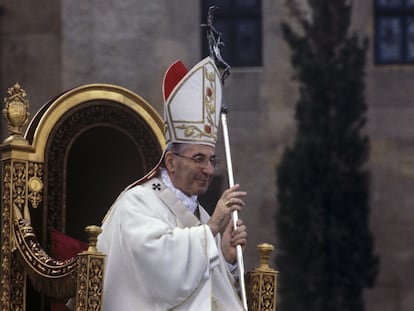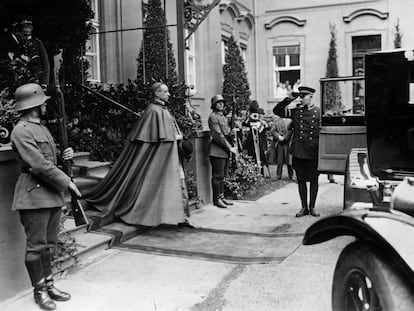John Paul I: The legend of a short-lived pope
Francis beatifies the pontiff who died 33 days after being elected and who inspired conspiracy theories and movies

Just like she had done for the previous 32 days, a nun named Vincenza Taffarel woke up before dawn on September 29, 1978, to make a cup of coffee for Albino Luciani, the newly elected Pope John Paul I. She took it to the vestry and left it there as usual for him to drink while he was dressing. A few minutes later, she peeked into the vestry and noticed that the cup of coffee was untouched. The nun opened the door to the pope’s bedroom and found him sitting up in bed, wearing his eyeglasses. The light was still on from the night before, and some papers he had been reading (some say it was The Imitation of Christ, a 15th-century devotional) were strewn about.
No one was prepared for the pope’s untimely death, nor for the news that a woman had entered a pope’s private quarters and found his corpse – imagine the rumors. But the ensuing Vatican response was badly botched – it issued a series of communications with conflicting information, changed its story several times, and refused to authorize an autopsy of Luciani, who served one of the most short-lived papal reigns in the history of the Roman Catholic Church. It’s a story that inspired novels, essays and movies for several decades, and resurfaced again with the announcement of the beatification of Pope John Paul I, miracle included. John Paul I is the fifth pontiff of the 20th century (Pius X, John XXIII, Paul VI and John Paul II) to be beatified, the last step before sainthood in the Roman Catholic Church.
Born in 1912, in Canale d’Agordo (northeastern Italy), Luciano’s death was a complete surprise, as was his election to the papacy. As he entered the papal conclave on August 26, 1978, there was no indication that he was the frontrunner. After only four votes, he emerged from the conclave as pope, converted by the Holy Spirit and an earthly disagreement about the other two leading candidates. Although it lasted only 33 days, his brief pontificate made lasting reforms to the Vatican’s financial management practices. His death, presumably due to a heart attack, was quickly engulfed in rumors and legends, and inspired a long list of movies and books that his postulators (beatification nominating team) characterize as fake news.
The truth is that the 66-year-old Luciani, the most recent Italian-born pope, was not feeling well that night. Diego Lorenzi, his private secretary, suggested calling a doctor, but the pope preferred not to bother. “Before retiring for the night, he met with the Archbishop of Milan, Cardinal Colombo, to talk about filling the post Luciani had just vacated in Venice. They had a long conversation and disagreed about whom to appoint. He then retired to his private quarters, and little else is known. He suffered a heart attack so severe that he didn’t even have time to press the bell next to the bed and ring for help,” says Giovanni Maria Vian, a church historian and former editor of L’Osservatore Romano, the daily Vatican City newspaper. Vian is the principal author of John Paul I, the Pope without a Crown. The Life and Death of John Paul I (2022), an illustrated biography of Luciani with contributions from other authors such as Juan Manuel de Prada.

The legend of John Paul I, who chose his name in honor of his two predecessors, is the product of a brief papacy and stormy year during which three different popes (Paul VI, John Paul I and John Paul II) appeared on the famous Vatican Palace balcony. It was a turbulent time for Italy. Former prime minister Aldo Moro had been kidnapped and assassinated three months earlier, and the country was being wracked by political turmoil, mafia crime and internecine war in the Italian secret services. According to Prada, the Vatican was not spared. “The fact that he died a month after being elected is extraordinary. From a supernatural perspective it leads to reflection, and if you are a believer, you wonder why God allowed the Vicar of Christ to die. But from an earthly perspective, it’s impossible not to speculate that his death was caused by dark forces. It was a very turbulent period in the history of the Church and the world,” says Prada.
Prada recalls the spate of fanciful books that came out after Luciani’s death – Death in the Vatican by Maurice Serral and Max Savigny (1983), and The Pope’s Guest: A Novel (2011) by Vladimir Volkoff. In The Pope’s Guest, the top Russian Orthodox prelate in Soviet-era Leningrad, dies in Luciani’s arms while in Rome for the installation of Pope John Paul I. Only 49 years old, the strange circumstances surrounding the death of Metropolitan Nikodim (secular name Boris Georgiyevich Rotov) added to all the speculation and rumors swirling around the pontiff.
Luciani was a linchpin between two worlds, two eras. But every transition to a new era opens the door for powerful storms to develop. Italian philosopher Antonio Gramsci sounded a warning at the beginning of the 20th century. “The old world is dying, the new is slow to appear. And in that chiaroscuro, monsters emerge.” Three such “monsters” emerged shortly after Luciani’s papacy. Roberto Calvi, chairman of the bankrupt Banco Ambrosiano, dubbed “God’s Banker” for his close association with the Holy See, was found dead from an apparent suicide in London. American archbishop Paul Marcinkus, then president of the Vatican Bank, became embroiled in a huge financial scandal due to the Vatican Bank’s large stake in the failed Banco Ambrosiano. Marcinkus was implicated in several major scandals, and was known for his practical management approach: “The Church is not governed with Hail Marys.” Then there is Italian financier, Licio Gelli, who was revealed in 1981 as being the Venerable Master of the clandestine masonic lodge Propaganda Due (P2). A character named Lico Lucchesi in The Godfather: Part III was based on Gelli. That film by Francis Ford Coppola is one of the best accounts of this period of transition in the Church (and the world), during which the new pope strives to restore order to the Vatican’s finances. Pope Francis, who has sometimes been compared to Luciani, has also proposed reforms to the Holy See’s vast real estate holdings. Then someone decided that 33 days of Pope John Paul I was enough.
Writer and film critic Emilio Ranzato, another contributor to Vian’s biography of Luciani, believes that Coppola’s film was the most faithful portrayal of that period, despite the inevitable artistic license. “When the film came out in 1990, Italians like me didn’t share that image of Italy. Most Italians now believe the story told in the film, with what we know now about the Banco Ambrosiano and Roberto Calvi’s murder, which was made to look like a suicide. And people now believe that clandestine forces did away with certain Vatican practices that had fallen into the hands of dangerous characters. The Godfather: Part III is not only a faithful account of the events and the time, but the movie also presaged an image [of Italy] that we share today.”
A rapidly fading respect
Numerous films touch on Luciani’s papacy, but Ranzato says that the Vatican’s treatment on the big screen changed after he passed away. “The relationship of cinema with the Holy See changed after Luciani’s death. There used to be a lot of respect for the clergy and Church traditions from the actors, directors, and writers. After the death of Pope John Paul I, this restraint completely disappeared. The knives came out and films began to explore the more mysterious and corrupt aspects of the Church. Murder and mystery stories… the Vatican was depicted in a disturbing light.”
The doubts surrounding Lucina’s death were mostly dispelled in 1989, when British journalist John Cornwell went to Rome to investigate an apparition of the Virgin Mary in Yugoslavia and was asked to investigate the true circumstances of the pope’s sudden death. The journalist was given access to the pontiff’s doctor, those who prepared his body for burial, and other people close to the event. Cornwell’s A Thief in the Night: Life and Death in the Vatican (1989) paints a picture of disregard for a pope who was often ridiculed in Vatican corridors and compared to comedian Peter Sellers for his supposed clumsiness. “There is no doubt that he died of natural causes,” says Vian, “but he was abandoned by his staff.” The postulators for Luciani’s beatification unsurprisingly agree that he died of natural causes, as does Ranzato, who doubts the practicality of killing the pope, despite the discontent about his election. “Many people just think he was unwell, and no one came to his aid that night.” Now he is one step away from becoming a saint.
Tu suscripción se está usando en otro dispositivo
¿Quieres añadir otro usuario a tu suscripción?
Si continúas leyendo en este dispositivo, no se podrá leer en el otro.
FlechaTu suscripción se está usando en otro dispositivo y solo puedes acceder a EL PAÍS desde un dispositivo a la vez.
Si quieres compartir tu cuenta, cambia tu suscripción a la modalidad Premium, así podrás añadir otro usuario. Cada uno accederá con su propia cuenta de email, lo que os permitirá personalizar vuestra experiencia en EL PAÍS.
¿Tienes una suscripción de empresa? Accede aquí para contratar más cuentas.
En el caso de no saber quién está usando tu cuenta, te recomendamos cambiar tu contraseña aquí.
Si decides continuar compartiendo tu cuenta, este mensaje se mostrará en tu dispositivo y en el de la otra persona que está usando tu cuenta de forma indefinida, afectando a tu experiencia de lectura. Puedes consultar aquí los términos y condiciones de la suscripción digital.
More information
Últimas noticias
Most viewed
- Sinaloa Cartel war is taking its toll on Los Chapitos
- Oona Chaplin: ‘I told James Cameron that I was living in a treehouse and starting a permaculture project with a friend’
- Reinhard Genzel, Nobel laureate in physics: ‘One-minute videos will never give you the truth’
- Why the price of coffee has skyrocketed: from Brazilian plantations to specialty coffee houses
- Silver prices are going crazy: This is what’s fueling the rally










































